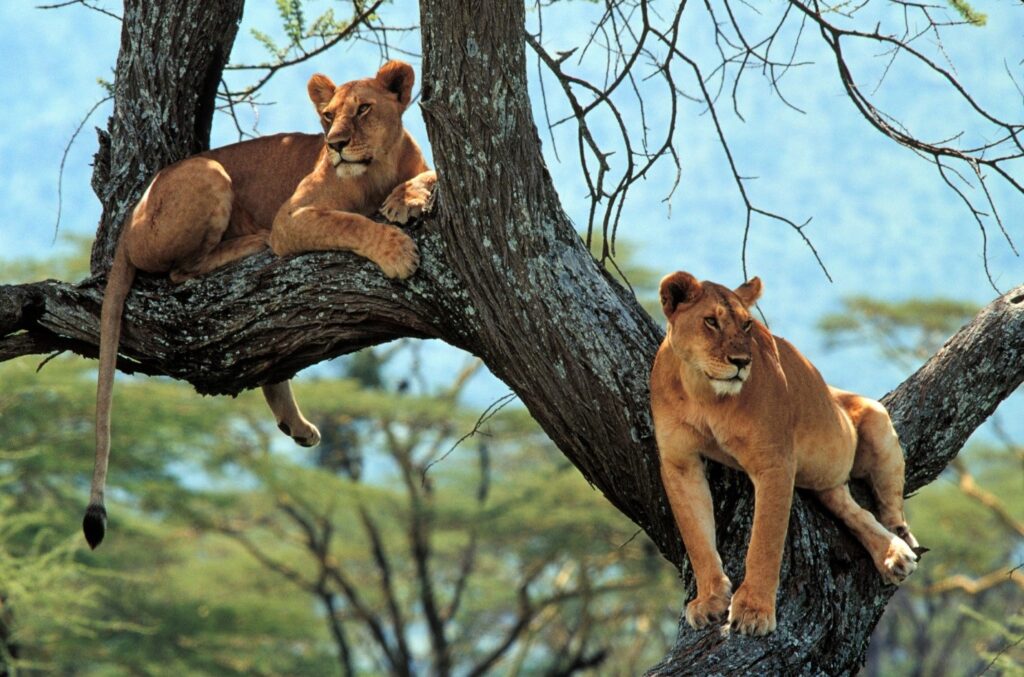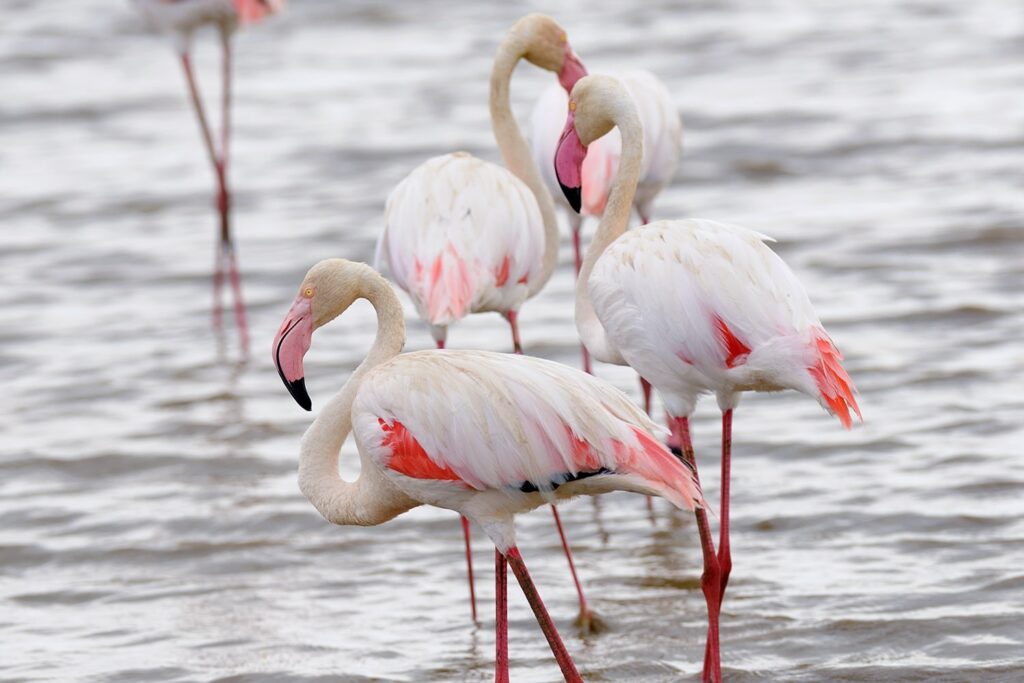

Lake Manyara national is a beautiful protected area located in Tanzania in Arusha and Manyara regions with city of Arusha, Babati as the nearest city, this park stretches over Lake Manyara and Great Rift Valley covering an area of 325 square kilometers with 230 square kilometers covered by Lake Manyara.
Lake Manyara national park is found in the northern safari circuit of Tanzania and situated along the route leading to Ngorongoro conservation area and Serengeti national park, the park is part of the larger Lake Manyara Biosphere Reserve established in 1981 by UNESCO as part of its man and the Biosphere Programme.
Historically Lake Manyara national park is named from a plant called Euphorbia tirucalli and locally known as Emanyara in Masai language, these trees were planted in the area by Masai people so as to guard their livestock from thieves and wild animals like lions and leopards. Lake Manyara national park was established as a reserve in 1957 but before its establishment it was used as a ground for sport hurting and a resident area for Masai people.
Tourist attractions in Lake Manyara national park
Lake Manyara
Lake Manyara is a shallow alkaline lake covering a reasonable area of Lake Manyara national park, the lake is a major attraction in the park covering a surface area of 230 square kilometers and a depth of 3.7 meters. Lake Manyara is the 7th largest lake in Tanzania at the surface elevation of 1,045 meters above the sea level, the lake is a great birding site hosting thousands of flamingoes which create a pink shade on the shores of the lake. Lake Manyara is a great site for birding and canoeing safari experience.
Wildlife
Lake Manyara national park hosts plenty of wildlife species thriving in marshlands, acacia woodlands, savannah grassland dominated area of the park and the forest galleries, and the park is famous for hosting tree climbing trees, huge population of elephants and a huge troop of baboons with over 100 individuals which is considered to be the largest in Africa. Other animals residing in Lake Manyara national park include hippos, antelopes, zebras, Thomson gazelle and Grant ’s gazelle, wildebeests, waterbuck, impalas, warthogs, giraffes cape buffalo and many more. Lake Manyara national park is a home to many predators such as lions, leopard, African wild cat, spotted hyena, bat-eared fox, genet, honey badger and serval, cheetah and African golden cats are occasionally spotted in the park.
Birdlife
Lake Manyara national park is a great habitat for bird life host exceptional bird species, in the park most bird species live on the banks and in the middle of Lake Manyara and others in the savannah woodlands. Lake Manyara national park is a habitat for over 400 bird species with migratory species from Eurasian locations, raptors, unique and endangered species to (Rufous tailed weaver, Ashy starlings and black-collared lovebird). Bird species in this park include pink shaded flamingoes, pelicans, crowned eagles, crested guinea fowl, slivery checked hornbills, egrets, stilts, herons, spoonbills, stalks, wanders, Narina trogon, pangani long claw, crowned hornbills, Schalow’s turaco, emerald cuckoo, crowned plover, two-banded courser, black-faced sun grouse and many more.
Maji Moto springs
Maji moto springs is a magnificent feature situated in the southern region of the park, these hot springs are named from a Swahili word meaning hot water. Maji moto springs is surrounded by palm and fig trees making it a small paradise amidst the park, the springs heat to about 60 degrees Celsius and the water crates a pool where visitors of the park can take a swim.
Tourist activities to do in Lake Manyara national park
Game viewing
Lake Manyara national park is a grand destination for exciting game viewing experience , this experience offers an opportunity to explore the park and together with safari guide you will visit various sections of the park on a game drive. On this experience you will visit the magnificent lake Manyara where you will spot thousands of animals as they drink water and bird, then drive through marshlands, woodlands and acacia dominated terrain spotting animals like tree climbing lions, elephants, hippos, antelopes, zebras, Thomson gazelle and Grant ’s gazelle, wildebeests, waterbuck, impalas, warthogs, giraffes cape buffalo and many more .
Lake Manyara national park offers both day and night game viewing, night game viewing a very exciting safari experience offering sights of a new dimension of the park. This experience an opportunity for spotting nocturnal animals and predators living in Lake Manyara national park, with a help of a spotlight you will spot lions who are more active at night, leopards, African wild cat, spotted hyena, bat-eared fox, genet, honey badger, serval and occasional cheetah.
Birding
Lake Manyara national park is one of the best protected areas in Tanzania for birding experience, the park is home to over 400 bird species residing around lake Manyara, savannah grasslands and the forest galleries dotted around. Birding in Lake Manyara national park offers an opportunity to spot wonderful and colorful bird species such as thousands of pink shaded flamingoes in the waters and shores of lake Manyara, flocks of pelicans, the rare pangani long claw, silvery-checked hornbill, crowned eagles, crested guinea fowl, slivery checked hornbills, egrets, stilts, herons, spoonbills, stalks, wanders, Narina trogon, pangani long claw, crowned hornbills, Schalow’s turaco, emerald cuckoo, crowned plover, two-banded courser, black-faced sun grouse and many more.
The best site for birding in Lake Manyara national park is Lake Manyara which is always crowded by thousands of pelicans and pink flamingoes, the huge populations of birds makes the park a paradise for birders.
Canoeing
Canoeing in Lake Manyara national park offers a way of touring the beautiful Lake Manyara, this park is one of the few protected areas in Tanzania offering canoeing safari experience. Canoeing experience gets the tourists close to the aquatic life of Lake Manyara with sights of thousands of flamingoes, pelicans and many animals which come to the lake to drink water.
Masai community visit
Masai local community is situated on the boundaries of Lake Manyara national park, historically the Masai people are the early inhabitants of park and visiting the Masai community offers cultural and traditional tour while in Lake Manyara national park. In the Masai community you will enjoy sights of the circular of the huts/bomas made out of mad and straws, be entertained traditional dances and songs, traditional wear of stripped shukas, local cuisines prepared in a local way and many more aspect of the indigenous cultural heritage.
Accommodation in Lake Manyara national park
In Lake Manyara national park accommodation is got from various lodges and camp which are open to receive visitors throughout the year, these include lake Manyara hotel, lake Manyara bush camp, andbeyond lake Manyara tree lodge, Africa safari glamping, lake Manyara kilimamoja lodge, lake Manyara wildlife lodge, Migunga tented camp, lake Manyara serene safari lodge, lake Manyara Tortilis camp and many more.
How to get to Lake Manyara national park
Lake Manyara national park in a distance of about 126 kilometers south west of Arusha where most safari trips to Lake Manyara national park start from , from Arusha the park is accessed by road and air means of transport. By road transport there is well kept routes leading to the park in a drive of approximately 1-2 hours, by air means of transport domestic flights are offered from Arusha airport to Lake Manyara airport serving Lake Manyara national park and Manyara region.
Climate in Lake Manyara national park
Lake Manyara national park experiences two rain seasons and one dry season, the rain seasons in the park consists of short rains and long rains. Short rains are experienced in the period of November – December and long rains in the period of March to May, Lake Manyara national park experiences the high rainfall in April with 161 mm. The dry season is experienced in the months of July, August and September, September is the driest month experiencing the lowest average of rainfall.
Temperature wise the warmest month in Lake Manyara national park are January, February and march experiencing 30 degrees Celsius and the lowest average high temperature is experienced in the months of June and July with an average of 25 degrees Celsius.
WhatsApp us